

The fear that comes with a cancer diagnosis has roots in the disease’s killer nature. Cancer is the second leading cause of death worldwide, killing more than 9 million people in 2018, according to the World Health Organization and causing 1 in 6 deaths.
In the United States, where the disease is also the second biggest killer, nearly 600,000 people die from it a year, according to the Centers for Disease Control and Prevention.
There is some encouraging news. Cancer death rates declined by 27% in the period between 1991 and 2016, according to the American Cancer Society. This trend is mostly attributed to the decline in smoking rate and better early detection. On the other hand, cancer diagnoses are expected to rise to nearly 23.6 million by 2030, according to the National Cancer Institute. The reason for the increased diagnoses is the fact that people live longer and the risk of developing the disease increases with age, according to Dr. Joseph Lynch, an oncologist from Geisinger. Age is the biggest risk factor for cancer.
While climbing cancer rates are discouraging, there is some good news. “Many types of cancer are increasingly becoming a chronic illness,” Lynch said. In other words, more people are now able to live longer with the disease.
Click here for the states with the highest and lowest cancer rates.
Click here for our detailed findings and methodology.
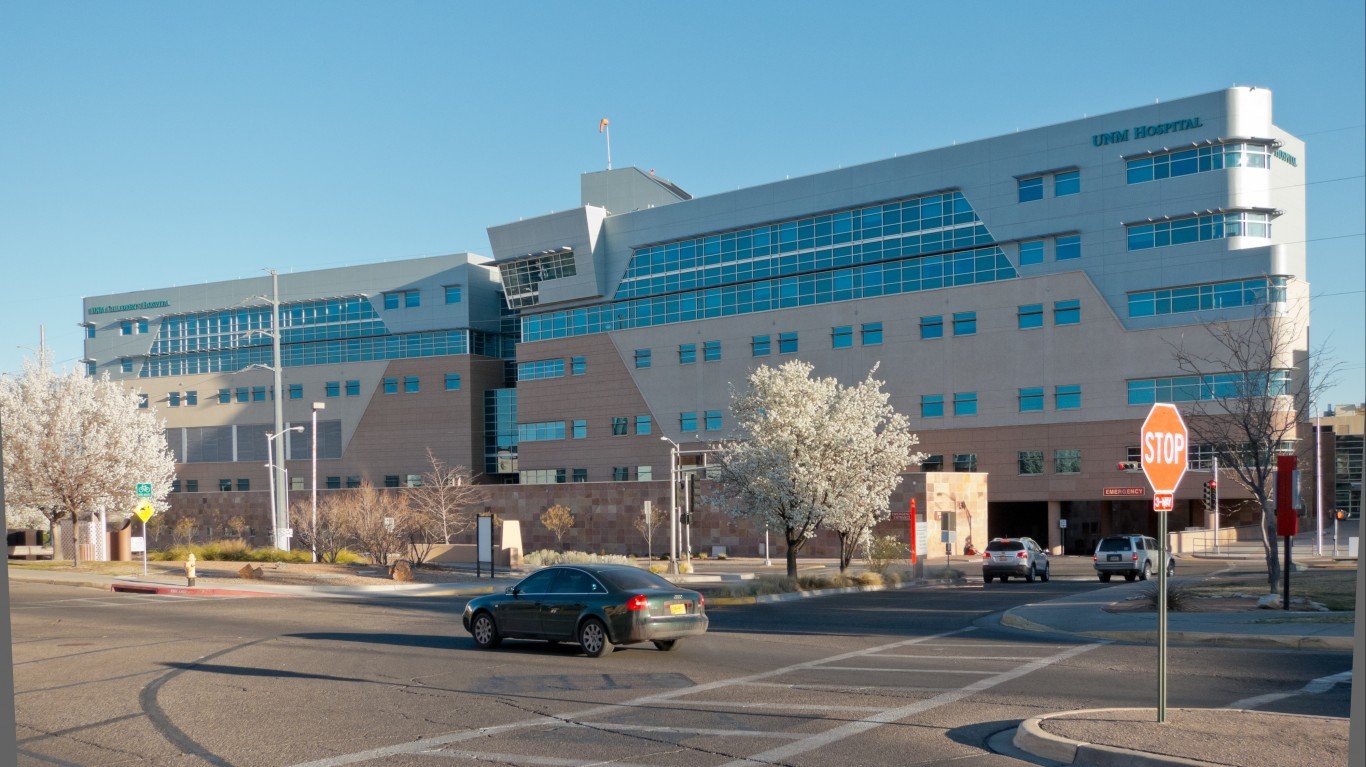
50. New Mexico
> Cancer diagnoses in 2016 per 100K: 359.4 (77 fewer than U.S. avg. of 436)
> Total number of cancer diagnoses in 2016: 9,075
> Cancer deaths: 3,560 or 139.8 per 100K (5th lowest)
> Female breast cancer incidence: 1,395 or 106.6 per 100K (the lowest)
> Prostate cancer incidence: 1,039 or 79.7 per 100K (3rd lowest)
> Lung cancer incidence: 950 or 36.4 per 100K (2nd lowest)
> Adult smoking rate: 16.6% (21st lowest)
> Adult obesity rate: 25.6% (8th lowest)
> Residents without health insurance: 9.5% (16th highest)
[in-text-ad]
49. Arizona
> Cancer diagnoses in 2016 per 100K: 376.3 (60 fewer than U.S. avg. of 436)
> Total number of cancer diagnoses in 2016: 31,443
> Cancer deaths: 11,876 or 138.6 per 100K (4th lowest)
> Female breast cancer incidence: 4,890 or 115.0 per 100K (7th lowest)
> Prostate cancer incidence: 3,061 or 72.3 per 100K (the lowest)
> Lung cancer incidence: 3,886 or 44.3 per 100K (5th lowest)
> Adult smoking rate: 14.7% (13th lowest)
> Adult obesity rate: 27.2% (15th lowest)
> Residents without health insurance: 10.6% (10th highest)
48. Nevada
> Cancer diagnoses in 2016 per 100K: 385.0 (51 fewer than U.S. avg. of 436)
> Total number of cancer diagnoses in 2016: 13,054
> Cancer deaths: 5,214 or 158.8 per 100K (24th lowest)
> Female breast cancer incidence: 1,925 or 111.7 per 100K (4th lowest)
> Prostate cancer incidence: 1,389 or 77.9 per 100K (2nd lowest)
> Lung cancer incidence: 1,724 or 50.5 per 100K (11th lowest)
> Adult smoking rate: 16.5% (20th lowest)
> Adult obesity rate: 26.5% (13th lowest)
> Residents without health insurance: 11.2% (7th highest)
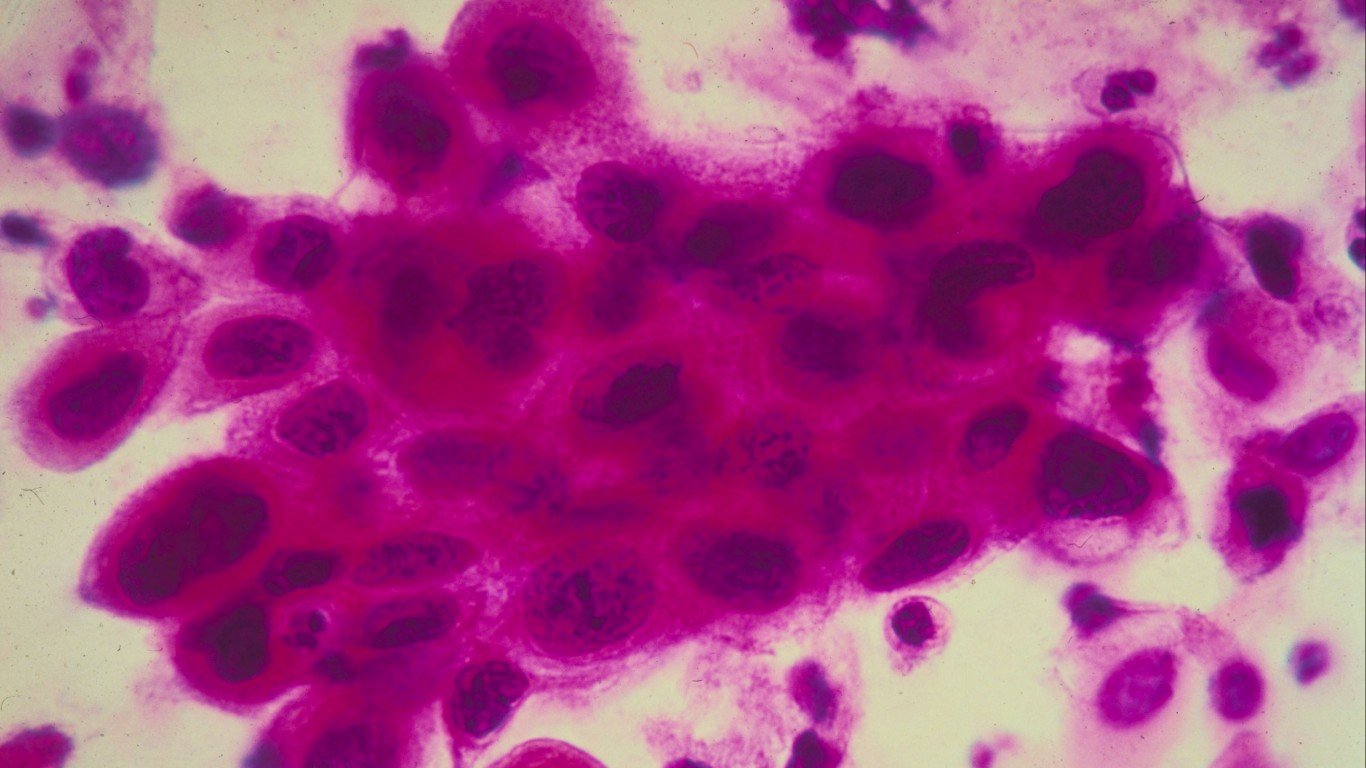
47. California
> Cancer diagnoses in 2016 per 100K: 385.6 (50 fewer than U.S. avg. of 436)
> Total number of cancer diagnoses in 2016: 164,887
> Cancer deaths: 59,513 or 140.2 per 100K (6th lowest)
> Female breast cancer incidence: 26,470 or 118.3 per 100K (12th lowest)
> Prostate cancer incidence: 17,793 or 85.1 per 100K (6th lowest)
> Lung cancer incidence: 16,177 or 38.2 per 100K (3rd lowest)
> Adult smoking rate: 11.0% (2nd lowest)
> Adult obesity rate: 22.7% (2nd lowest)
> Residents without health insurance: 7.2% (21st lowest)
[in-text-ad-2]
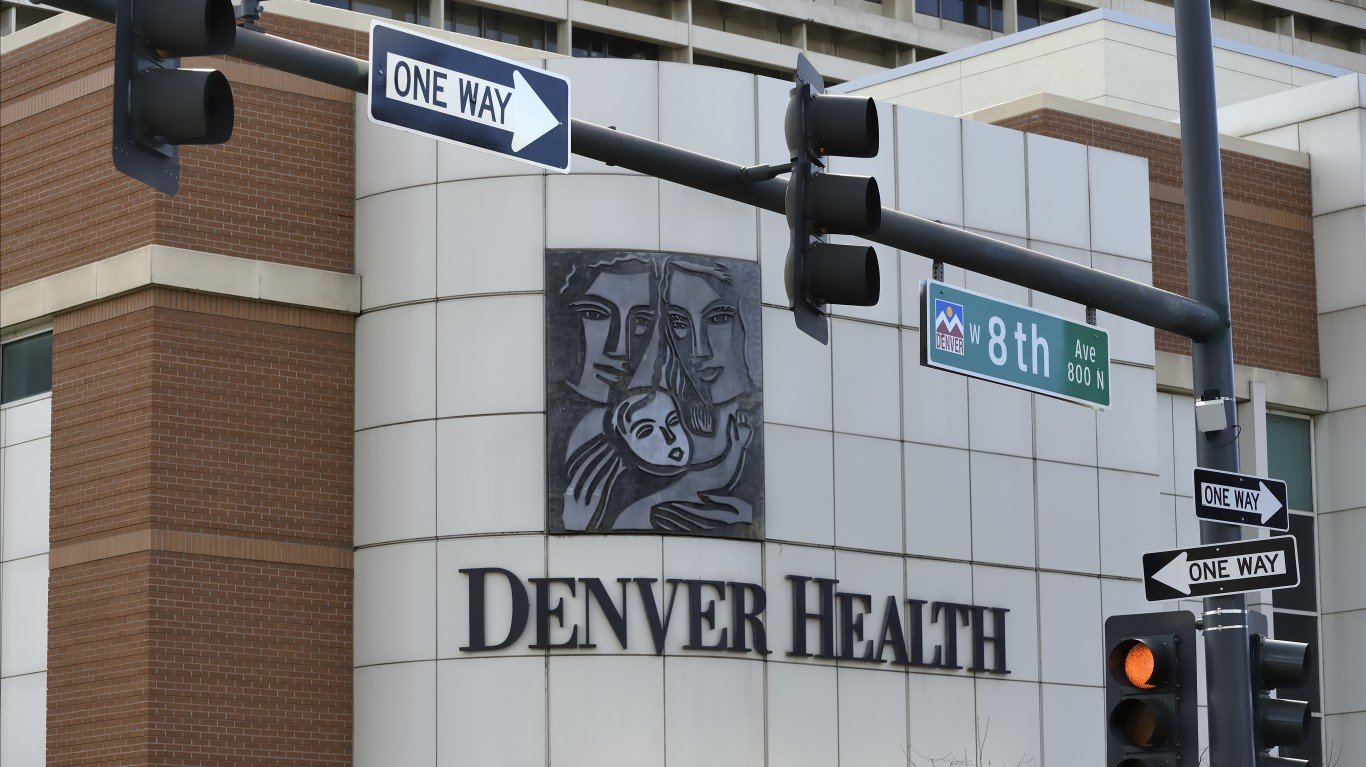
46. Colorado
> Cancer diagnoses in 2016 per 100K: 388.8 (47 fewer than U.S. avg. of 436)
> Total number of cancer diagnoses in 2016: 23,244
> Cancer deaths: 7,928 or 138.3 per 100K (3rd lowest)
> Female breast cancer incidence: 3,959 or 127.4 per 100K (25th highest)
> Prostate cancer incidence: 2,610 or 85.9 per 100K (7th lowest)
> Lung cancer incidence: 2,346 or 40.2 per 100K (4th lowest)
> Adult smoking rate: 15.6% (17th lowest)
> Adult obesity rate: 21.0% (the lowest)
> Residents without health insurance: 7.5% (24th lowest)
45. Utah
> Cancer diagnoses in 2016 per 100K: 390.6 (45 fewer than U.S. avg. of 436)
> Total number of cancer diagnoses in 2016: 10,494
> Cancer deaths: 3,125 or 123.3 per 100K (the lowest)
> Female breast cancer incidence: 1,561 or 114.4 per 100K (5th lowest)
> Prostate cancer incidence: 1,473 or 112.0 per 100K (15th highest)
> Lung cancer incidence: 652 or 25.1 per 100K (the lowest)
> Adult smoking rate: 8.8% (the lowest)
> Adult obesity rate: 25.9% (10th lowest)
> Residents without health insurance: 9.4% (17th highest)
[in-text-ad]

44. Texas
> Cancer diagnoses in 2016 per 100K: 391.8 (44 fewer than U.S. avg. of 436)
> Total number of cancer diagnoses in 2016: 109,083
> Cancer deaths: 40,195 or 149.3 per 100K (15th lowest)
> Female breast cancer incidence: 15,897 or 107.6 per 100K (2nd lowest)
> Prostate cancer incidence: 11,970 or 89.2 per 100K (11th lowest)
> Lung cancer incidence: 13,199 or 48.5 per 100K (9th lowest)
> Adult smoking rate: 14.3% (10th lowest)
> Adult obesity rate: 29.0% (24th lowest)
> Residents without health insurance: 17.7% (the highest)

43. Wyoming
> Cancer diagnoses in 2016 per 100K: 402.3 (34 fewer than U.S. avg. of 436)
> Total number of cancer diagnoses in 2016: 2,775
> Cancer deaths: 962 or 140.6 per 100K (7th lowest)
> Female breast cancer incidence: 410 or 117.8 per 100K (11th lowest)
> Prostate cancer incidence: 408 or 111.5 per 100K (19th highest)
> Lung cancer incidence: 316 or 44.7 per 100K (7th lowest)
> Adult smoking rate: 18.9% (17th highest)
> Adult obesity rate: 28.5% (21st lowest)
> Residents without health insurance: 10.5% (11th highest)

42. Massachusetts
> Cancer diagnoses in 2016 per 100K: 404.2 (32 fewer than U.S. avg. of 436)
> Total number of cancer diagnoses in 2016: 33,626
> Cancer deaths: 12,717 or 149.9 per 100K (16th lowest)
> Female breast cancer incidence: 6,032 or 139.3 per 100K (2nd highest)
> Prostate cancer incidence: 3,925 or 94.9 per 100K (18th lowest)
> Lung cancer incidence: 4,835 or 56.7 per 100K (23rd lowest)
> Adult smoking rate: 13.6% (5th lowest)
> Adult obesity rate: 24.4% (4th lowest)
> Residents without health insurance: 2.8% (the lowest)
[in-text-ad-2]
41. Oregon
> Cancer diagnoses in 2016 per 100K: 405.3 (31 fewer than U.S. avg. of 436)
> Total number of cancer diagnoses in 2016: 20,596
> Cancer deaths: 8,078 or 157.7 per 100K (22nd lowest)
> Female breast cancer incidence: 3,080 or 118.6 per 100K (13th lowest)
> Prostate cancer incidence: 2,305 or 86.7 per 100K (9th lowest)
> Lung cancer incidence: 2,608 or 50.1 per 100K (10th lowest)
> Adult smoking rate: 16.2% (19th lowest)
> Adult obesity rate: 28.3% (20th lowest)
> Residents without health insurance: 7.1% (20th lowest)

40. Alaska
> Cancer diagnoses in 2016 per 100K: 405.8 (30 fewer than U.S. avg. of 436)
> Total number of cancer diagnoses in 2016: 2,882
> Cancer deaths: 995 or 159.3 per 100K (23rd highest)
> Female breast cancer incidence: 411 or 114.8 per 100K (6th lowest)
> Prostate cancer incidence: 362 or 93.6 per 100K (13th lowest)
> Lung cancer incidence: 362 or 54.9 per 100K (18th lowest)
> Adult smoking rate: 19.0% (16th highest)
> Adult obesity rate: 30.4% (21st highest)
> Residents without health insurance: 12.6% (5th highest)
[in-text-ad]

39. Virginia
> Cancer diagnoses in 2016 per 100K: 413.3 (23 fewer than U.S. avg. of 436)
> Total number of cancer diagnoses in 2016: 40,322
> Cancer deaths: 15,027 or 156.4 per 100K (20th lowest)
> Female breast cancer incidence: 6,455 or 126.4 per 100K (25th lowest)
> Prostate cancer incidence: 4,757 or 97.3 per 100K (20th lowest)
> Lung cancer incidence: 5,635 or 56.6 per 100K (22nd lowest)
> Adult smoking rate: 15.3% (15th lowest)
> Adult obesity rate: 28.8% (23rd lowest)
> Residents without health insurance: 8.8% (19th highest)

38. Hawaii
> Cancer diagnoses in 2016 per 100K: 414.2 (22 fewer than U.S. avg. of 436)
> Total number of cancer diagnoses in 2016: 7,395
> Cancer deaths: 2,401 or 127.9 per 100K (2nd lowest)
> Female breast cancer incidence: 1,201 or 133.2 per 100K (10th highest)
> Prostate cancer incidence: 839 or 93.8 per 100K (15th lowest)
> Lung cancer incidence: 820 or 44.5 per 100K (6th lowest)
> Adult smoking rate: 13.1% (3rd lowest)
> Adult obesity rate: 23.1% (3rd lowest)
> Residents without health insurance: 4.1% (4th lowest)

37. Florida
> Cancer diagnoses in 2016 per 100K: 419.3 (17 fewer than U.S. avg. of 436)
> Total number of cancer diagnoses in 2016: 119,408
> Cancer deaths: 44,266 or 146.8 per 100K (11th lowest)
> Female breast cancer incidence: 16,601 or 116.5 per 100K (8th lowest)
> Prostate cancer incidence: 12,434 or 86.4 per 100K (8th lowest)
> Lung cancer incidence: 16,878 or 55.3 per 100K (20th lowest)
> Adult smoking rate: 15.5% (16th lowest)
> Adult obesity rate: 26.5% (13th lowest)
> Residents without health insurance: 13.0% (4th highest)
[in-text-ad-2]

36. Michigan
> Cancer diagnoses in 2016 per 100K: 436.8 (1 more than U.S. avg. of 436)
> Total number of cancer diagnoses in 2016: 53,911
> Cancer deaths: 20,870 or 166.1 per 100K (15th highest)
> Female breast cancer incidence: 7,799 or 123.3 per 100K (19th lowest)
> Prostate cancer incidence: 6,686 or 105.9 per 100K (23rd highest)
> Lung cancer incidence: 7,676 or 60.0 per 100K (21st highest)
> Adult smoking rate: 20.4% (11th highest)
> Adult obesity rate: 31.7% (16th highest)
> Residents without health insurance: 5.4% (9th lowest)

35. Idaho
> Cancer diagnoses in 2016 per 100K: 439.2 (3 more than U.S. avg. of 436)
> Total number of cancer diagnoses in 2016: 8,354
> Cancer deaths: 2,884 or 152.8 per 100K (18th lowest)
> Female breast cancer incidence: 1,203 or 122.8 per 100K (18th lowest)
> Prostate cancer incidence: 1,030 or 105.0 per 100K (25th lowest)
> Lung cancer incidence: 920 or 47.8 per 100K (8th lowest)
> Adult smoking rate: 14.5% (12th lowest)
> Adult obesity rate: 28.3% (20th lowest)
> Residents without health insurance: 11.1% (8th highest)
[in-text-ad]

34. Maryland
> Cancer diagnoses in 2016 per 100K: 440.9 (5 more than U.S. avg. of 436)
> Total number of cancer diagnoses in 2016: 30,942
> Cancer deaths: 10,911 or 156.6 per 100K (21st lowest)
> Female breast cancer incidence: 4,815 or 128.6 per 100K (20th highest)
> Prostate cancer incidence: 4,149 or 120.9 per 100K (8th highest)
> Lung cancer incidence: 3,802 or 53.8 per 100K (17th lowest)
> Adult smoking rate: 13.7% (6th lowest)
> Adult obesity rate: 30.3% (22nd highest)
> Residents without health insurance: 6.0% (15th lowest)

33. South Carolina
> Cancer diagnoses in 2016 per 100K: 440.9 (5 more than U.S. avg. of 436)
> Total number of cancer diagnoses in 2016: 27,313
> Cancer deaths: 10,356 or 168.1 per 100K (13th highest)
> Female breast cancer incidence: 4,155 or 128.3 per 100K (22nd highest)
> Prostate cancer incidence: 3,498 or 111.6 per 100K (17th highest)
> Lung cancer incidence: 3,854 or 59.7 per 100K (22nd highest)
> Adult smoking rate: 20.0% (12th highest)
> Adult obesity rate: 32.4% (11th highest)
> Residents without health insurance: 10.5% (11th highest)

32. Vermont
> Cancer diagnoses in 2016 per 100K: 442.4 (6 more than U.S. avg. of 436)
> Total number of cancer diagnoses in 2016: 3,681
> Cancer deaths: 1,356 or 158.9 per 100K (25th highest)
> Female breast cancer incidence: 553 or 130.5 per 100K (15th highest)
> Prostate cancer incidence: 372 or 83.9 per 100K (5th lowest)
> Lung cancer incidence: 530 or 60.5 per 100K (20th highest)
> Adult smoking rate: 17.0% (24th lowest)
> Adult obesity rate: 25.5% (7th lowest)
> Residents without health insurance: 4.0% (2nd lowest)
[in-text-ad-2]
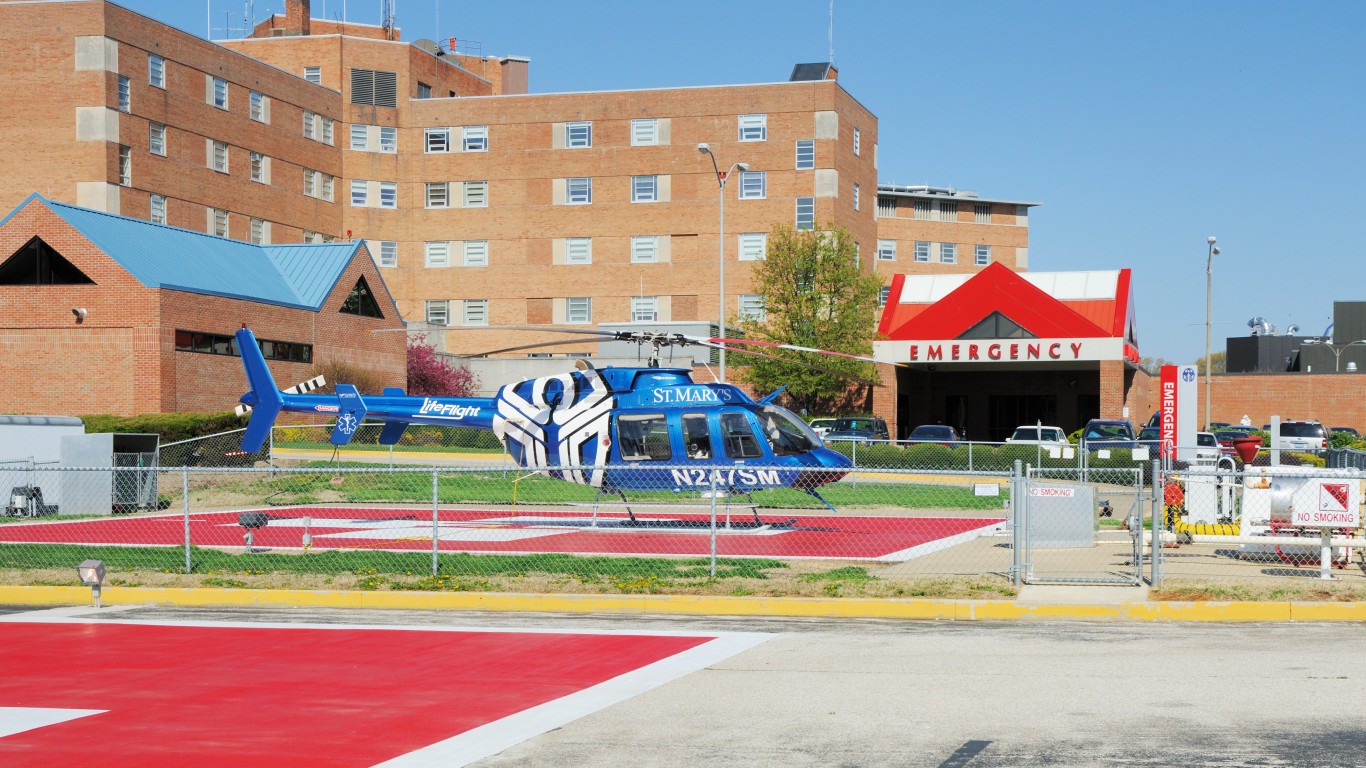
31. Indiana
> Cancer diagnoses in 2016 per 100K: 443.0 (7 more than U.S. avg. of 436)
> Total number of cancer diagnoses in 2016: 34,260
> Cancer deaths: 13,424 or 172.3 per 100K (9th highest)
> Female breast cancer incidence: 4,741 or 117.6 per 100K (10th lowest)
> Prostate cancer incidence: 3,424 or 89.5 per 100K (12th lowest)
> Lung cancer incidence: 5,567 or 70.4 per 100K (7th highest)
> Adult smoking rate: 21.1% (10th highest)
> Adult obesity rate: 32.8% (10th highest)
> Residents without health insurance: 8.3% (21st highest)

30. Washington
> Cancer diagnoses in 2016 per 100K: 445.1 (9 more than U.S. avg. of 436)
> Total number of cancer diagnoses in 2016: 37,378
> Cancer deaths: 12,594 or 152.6 per 100K (17th lowest)
> Female breast cancer incidence: 5,768 or 132.6 per 100K (12th highest)
> Prostate cancer incidence: 4,157 or 97.3 per 100K (20th lowest)
> Lung cancer incidence: 4,468 or 53.2 per 100K (14th lowest)
> Adult smoking rate: 13.9% (7th lowest)
> Adult obesity rate: 27.6% (17th lowest)
> Residents without health insurance: 6.4% (17th lowest)
[in-text-ad]
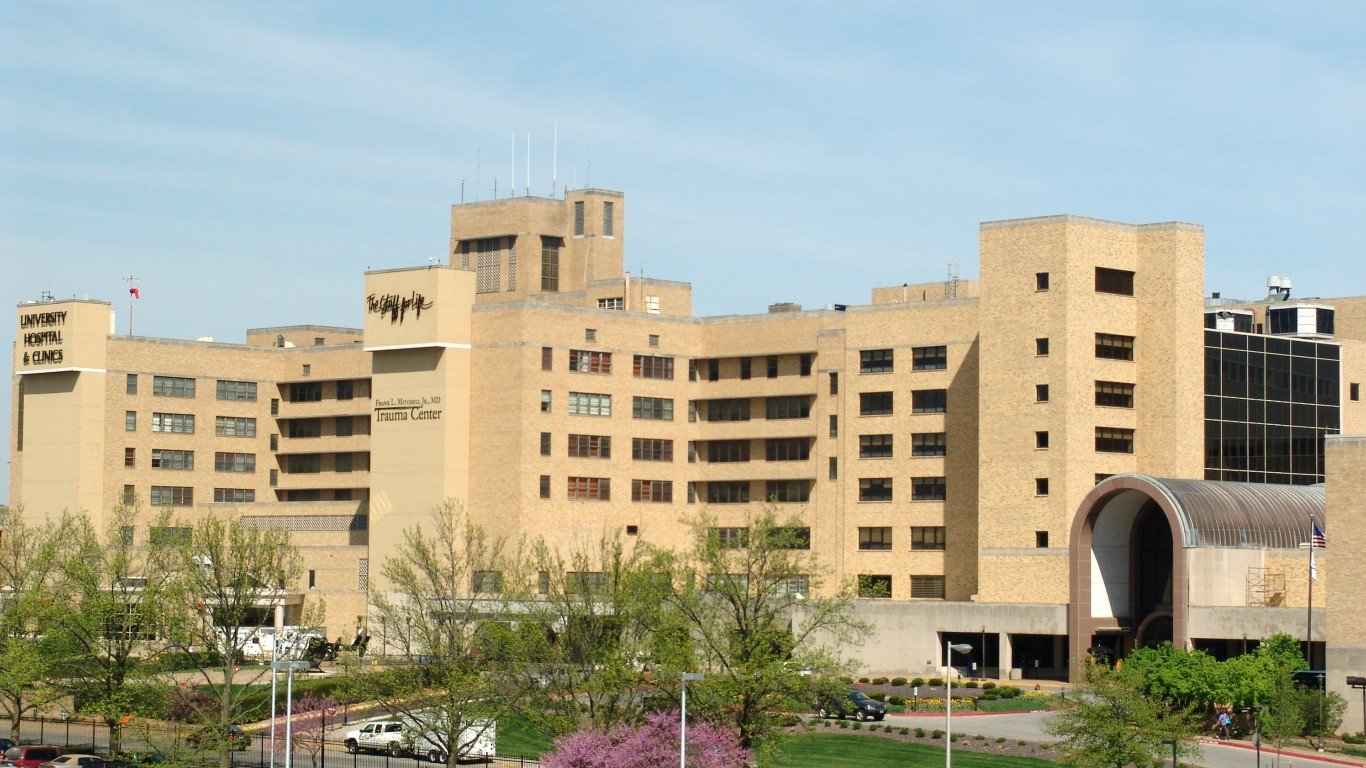
29. Missouri
> Cancer diagnoses in 2016 per 100K: 446.3 (10 more than U.S. avg. of 436)
> Total number of cancer diagnoses in 2016: 33,171
> Cancer deaths: 12,696 or 166.8 per 100K (14th highest)
> Female breast cancer incidence: 5,034 or 132.0 per 100K (14th highest)
> Prostate cancer incidence: 3,313 or 88.3 per 100K (10th lowest)
> Lung cancer incidence: 5,256 or 68.0 per 100K (9th highest)
> Adult smoking rate: 22.1% (7th highest)
> Adult obesity rate: 32.2% (12th highest)
> Residents without health insurance: 9.4% (17th highest)
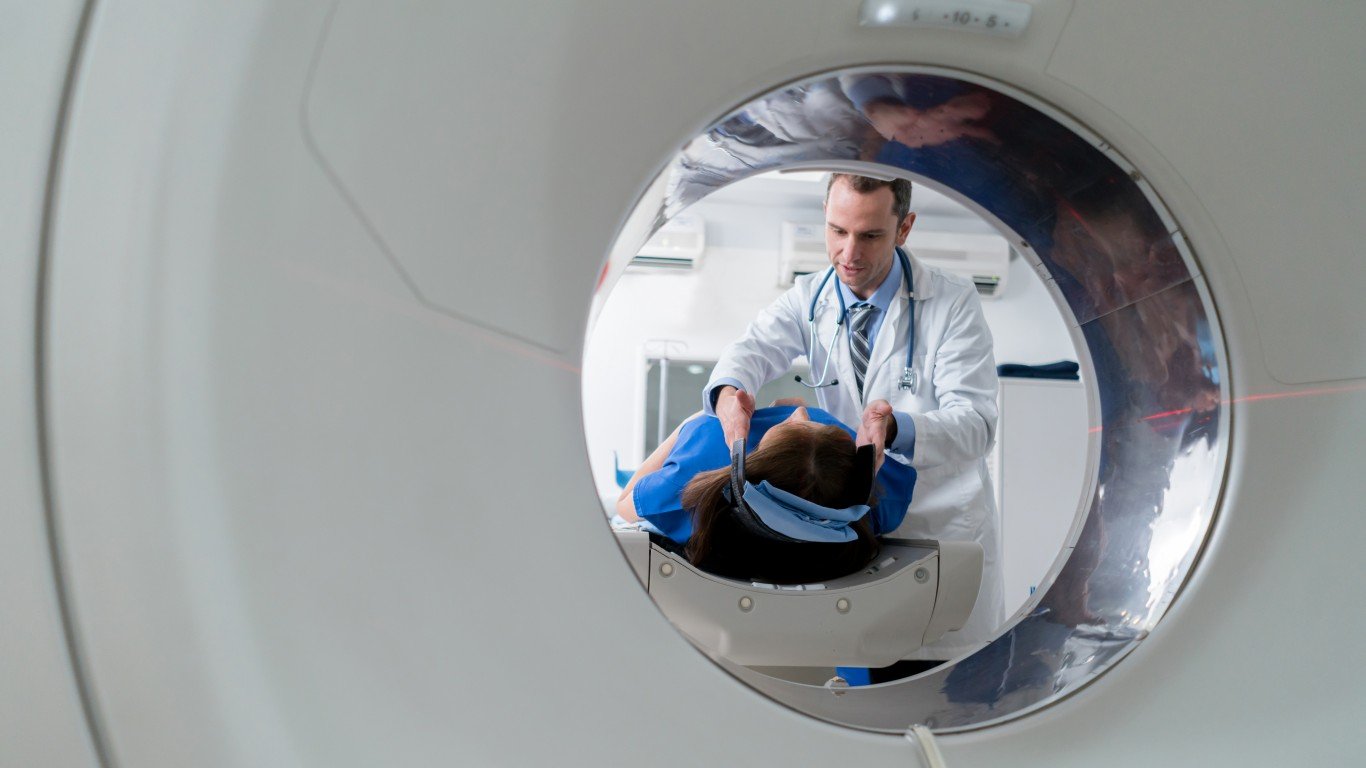
28. Nebraska
> Cancer diagnoses in 2016 per 100K: 446.4 (10 more than U.S. avg. of 436)
> Total number of cancer diagnoses in 2016: 9,838
> Cancer deaths: 3,477 or 154.1 per 100K (19th lowest)
> Female breast cancer incidence: 1,432 or 127.5 per 100K (24th highest)
> Prostate cancer incidence: 1,257 or 112.2 per 100K (14th highest)
> Lung cancer incidence: 1,160 or 51.2 per 100K (12th lowest)
> Adult smoking rate: 17.0% (23rd lowest)
> Adult obesity rate: 31.2% (17th highest)
> Residents without health insurance: 8.3% (21st highest)

27. Oklahoma
> Cancer diagnoses in 2016 per 100K: 447.9 (12 more than U.S. avg. of 436)
> Total number of cancer diagnoses in 2016: 20,167
> Cancer deaths: 8,115 or 178.5 per 100K (6th highest)
> Female breast cancer incidence: 2,930 or 125.9 per 100K (23rd lowest)
> Prostate cancer incidence: 2,104 or 93.7 per 100K (14th lowest)
> Lung cancer incidence: 2,955 or 63.3 per 100K (15th highest)
> Adult smoking rate: 19.6% (15th highest)
> Adult obesity rate: 33.3% (7th highest)
> Residents without health insurance: 14.2% (2nd highest)
[in-text-ad-2]

26. North Dakota
> Cancer diagnoses in 2016 per 100K: 448.7 (13 more than U.S. avg. of 436)
> Total number of cancer diagnoses in 2016: 3,765
> Cancer deaths: 1,253 or 143.0 per 100K (9th lowest)
> Female breast cancer incidence: 561 or 137.9 per 100K (4th highest)
> Prostate cancer incidence: 499 or 113.9 per 100K (10th highest)
> Lung cancer incidence: 459 or 53.6 per 100K (16th lowest)
> Adult smoking rate: 19.8% (13th highest)
> Adult obesity rate: 32.2% (12th highest)
> Residents without health insurance: 7.3% (22nd lowest)
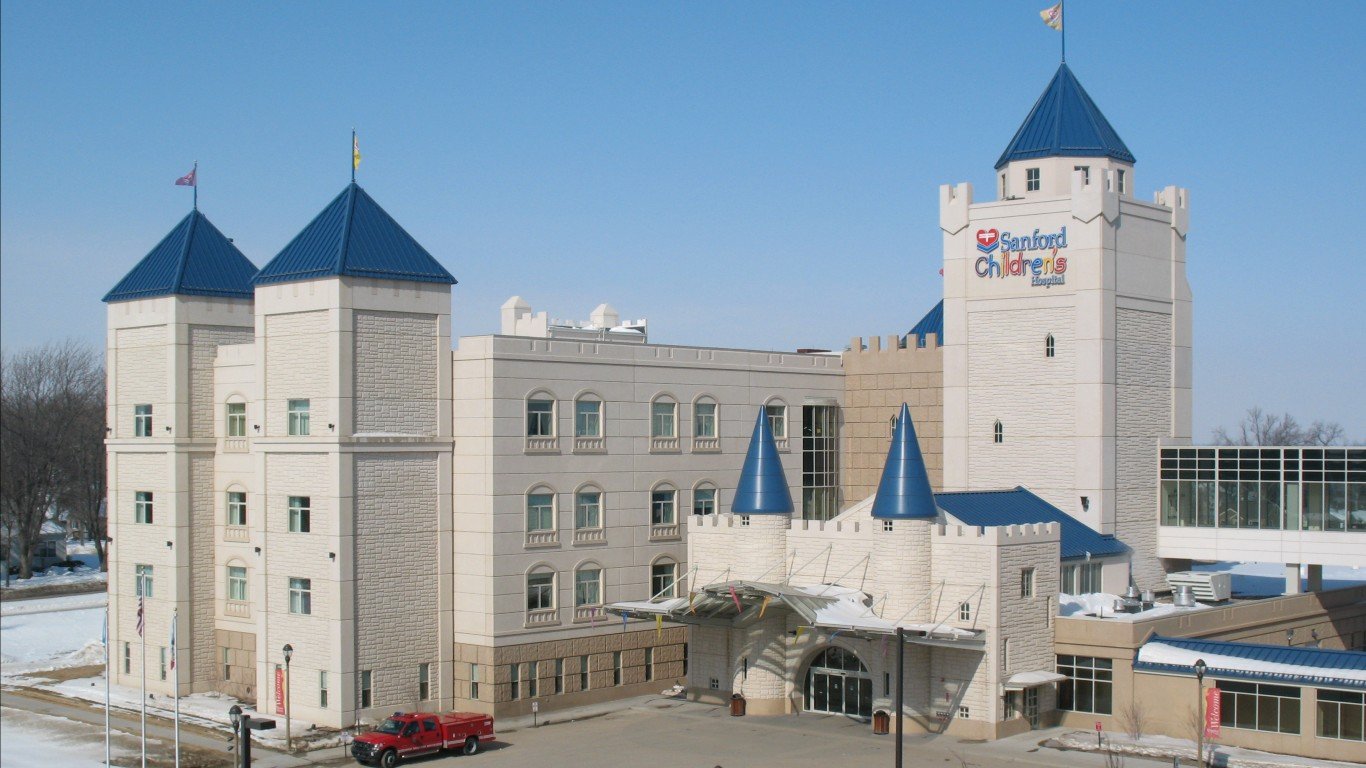
25. South Dakota
> Cancer diagnoses in 2016 per 100K: 449.5 (14 more than U.S. avg. of 436)
> Total number of cancer diagnoses in 2016: 4,612
> Cancer deaths: 1,694 or 160.5 per 100K (21st highest)
> Female breast cancer incidence: 569 or 111.4 per 100K (3rd lowest)
> Prostate cancer incidence: 615 or 112.6 per 100K (13th highest)
> Lung cancer incidence: 620 or 58.2 per 100K (25th lowest)
> Adult smoking rate: 18.1% (19th highest)
> Adult obesity rate: 31.1% (18th highest)
> Residents without health insurance: 9.8% (15th highest)
[in-text-ad]

24. Rhode Island
> Cancer diagnoses in 2016 per 100K: 450.6 (15 more than U.S. avg. of 436)
> Total number of cancer diagnoses in 2016: 5,972
> Cancer deaths: 2,171 or 158.4 per 100K (23rd lowest)
> Female breast cancer incidence: 924 or 135.4 per 100K (5th highest)
> Prostate cancer incidence: 607 or 94.0 per 100K (16th lowest)
> Lung cancer incidence: 937 or 68.5 per 100K (8th highest)
> Adult smoking rate: 14.4% (11th lowest)
> Adult obesity rate: 27.0% (14th lowest)
> Residents without health insurance: 4.1% (4th lowest)
23. Minnesota
> Cancer diagnoses in 2016 per 100K: 455.7 (20 more than U.S. avg. of 436)
> Total number of cancer diagnoses in 2016: 29,619
> Cancer deaths: 9,857 or 149.3 per 100K (15th lowest)
> Female breast cancer incidence: 4,274 or 128.6 per 100K (20th highest)
> Prostate cancer incidence: 3,364 or 101.5 per 100K (23rd lowest)
> Lung cancer incidence: 3,651 or 55.1 per 100K (19th lowest)
> Adult smoking rate: 15.2% (14th lowest)
> Adult obesity rate: 27.6% (17th lowest)
> Residents without health insurance: 4.4% (5th lowest)
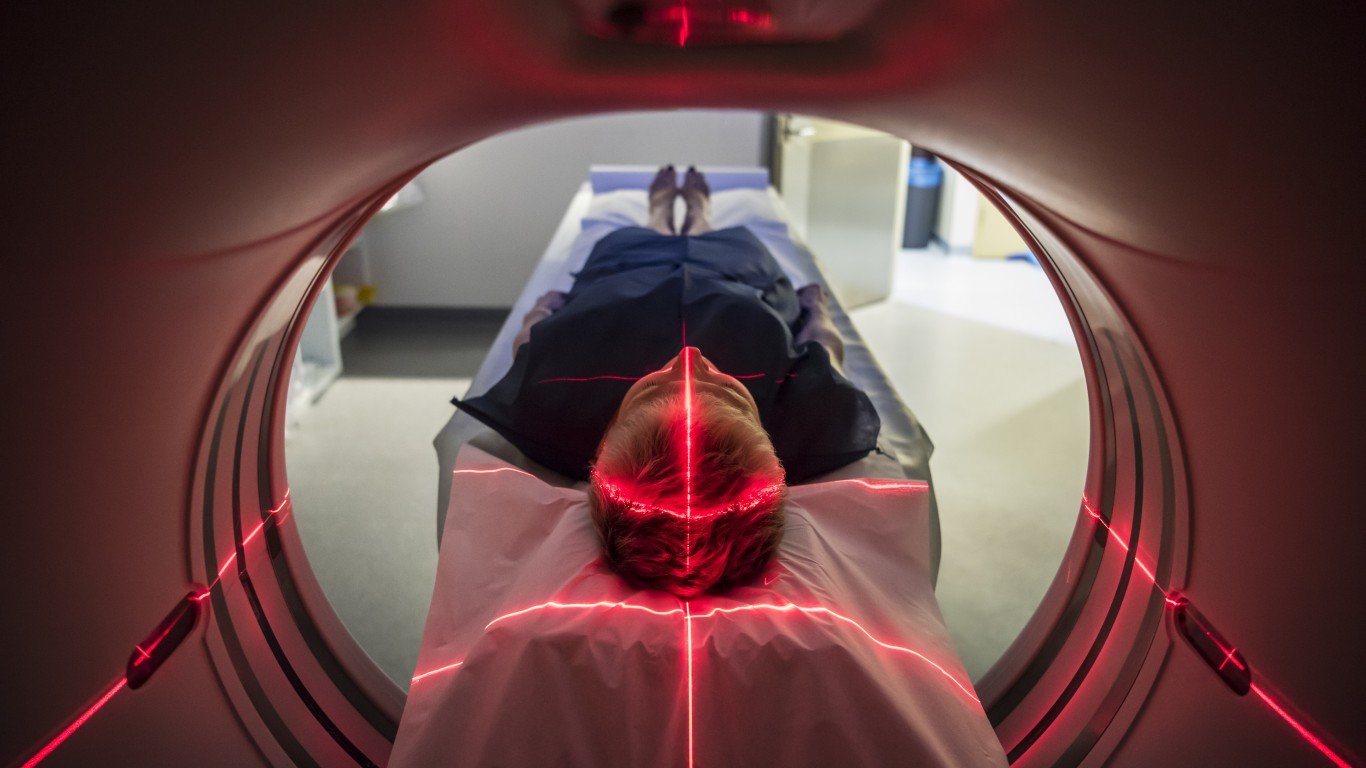
22. Tennessee
> Cancer diagnoses in 2016 per 100K: 455.7 (20 more than U.S. avg. of 436)
> Total number of cancer diagnoses in 2016: 36,598
> Cancer deaths: 14,450 or 180.5 per 100K (4th highest)
> Female breast cancer incidence: 4,993 or 119.2 per 100K (14th lowest)
> Prostate cancer incidence: 4,478 or 111.7 per 100K (16th highest)
> Lung cancer incidence: 5,900 or 70.9 per 100K (6th highest)
> Adult smoking rate: 22.1% (8th highest)
> Adult obesity rate: 33.0% (9th highest)
> Residents without health insurance: 10.1% (13th highest)
[in-text-ad-2]

21. Ohio
> Cancer diagnoses in 2016 per 100K: 456.1 (20 more than U.S. avg. of 436)
> Total number of cancer diagnoses in 2016: 65,645
> Cancer deaths: 25,509 or 173.5 per 100K (8th highest)
> Female breast cancer incidence: 9,648 or 128.7 per 100K (19th highest)
> Prostate cancer incidence: 7,316 or 100.7 per 100K (21st lowest)
> Lung cancer incidence: 9,652 or 64.9 per 100K (12th highest)
> Adult smoking rate: 22.5% (6th highest)
> Adult obesity rate: 31.8% (15th highest)
> Residents without health insurance: 6.5% (18th lowest)
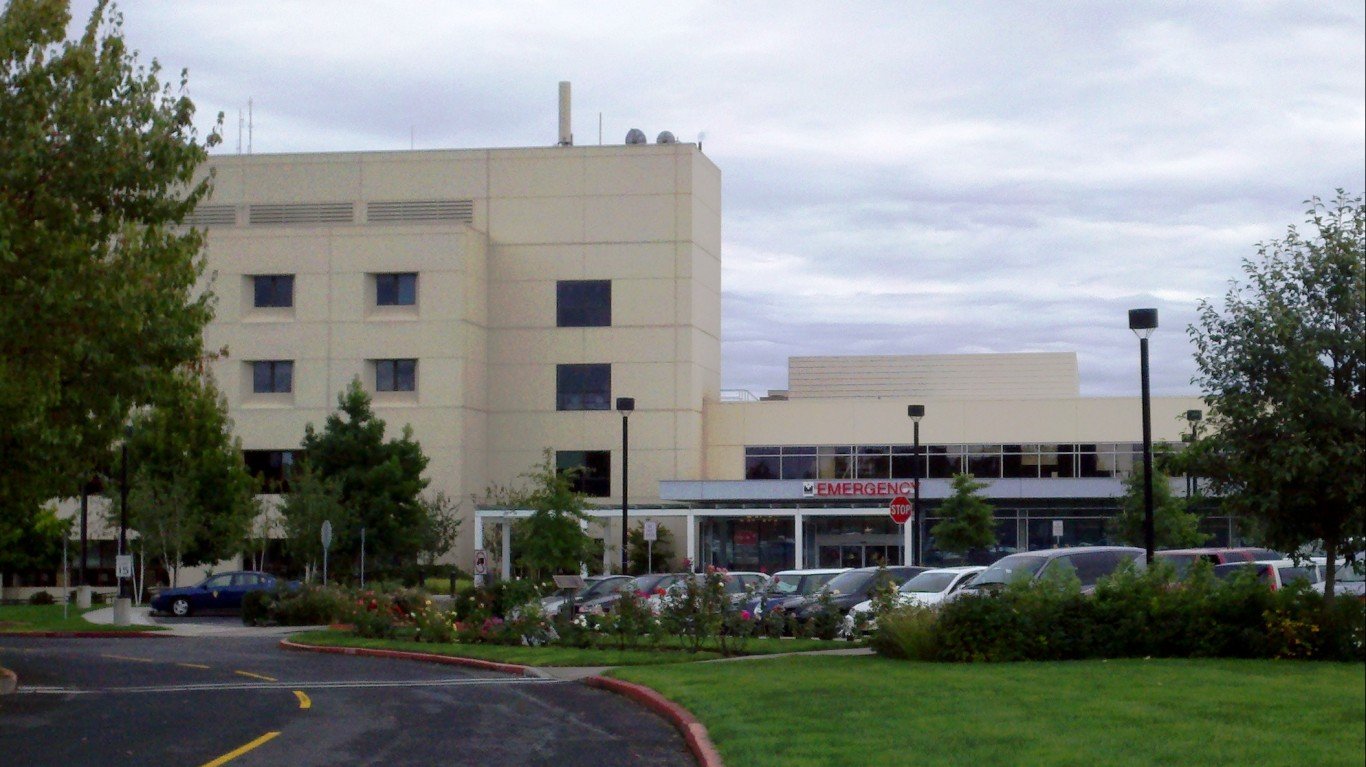
20. Montana
> Cancer diagnoses in 2016 per 100K: 456.6 (21 more than U.S. avg. of 436)
> Total number of cancer diagnoses in 2016: 6,194
> Cancer deaths: 2,031 or 148.2 per 100K (12th lowest)
> Female breast cancer incidence: 836 or 125.1 per 100K (21st lowest)
> Prostate cancer incidence: 927 or 125.3 per 100K (4th highest)
> Lung cancer incidence: 727 or 52.2 per 100K (13th lowest)
> Adult smoking rate: 18.5% (18th highest)
> Adult obesity rate: 25.4% (5th lowest)
> Residents without health insurance: 8.2% (23rd highest)
[in-text-ad]
19. Kansas
> Cancer diagnoses in 2016 per 100K: 457.3 (21 more than U.S. avg. of 436)
> Total number of cancer diagnoses in 2016: 15,312
> Cancer deaths: 5,484 or 158.9 per 100K (25th highest)
> Female breast cancer incidence: 2,262 or 132.3 per 100K (13th highest)
> Prostate cancer incidence: 1,695 or 101.8 per 100K (24th lowest)
> Lung cancer incidence: 1,918 or 55.4 per 100K (21st lowest)
> Adult smoking rate: 17.2% (25th highest)
> Adult obesity rate: 33.2% (8th highest)
> Residents without health insurance: 8.8% (19th highest)

18. Alabama
> Cancer diagnoses in 2016 per 100K: 457.8 (22 more than U.S. avg. of 436)
> Total number of cancer diagnoses in 2016: 27,195
> Cancer deaths: 10,419 or 174.3 per 100K (7th highest)
> Female breast cancer incidence: 3,810 or 122.4 per 100K (17th lowest)
> Prostate cancer incidence: 3,597 or 122.3 per 100K (7th highest)
> Lung cancer incidence: 3,985 or 64.2 per 100K (13th highest)
> Adult smoking rate: 21.5% (9th highest)
> Adult obesity rate: 35.1% (5th highest)
> Residents without health insurance: 10.0% (14th highest)

17. North Carolina
> Cancer diagnoses in 2016 per 100K: 458.4 (22 more than U.S. avg. of 436)
> Total number of cancer diagnoses in 2016: 55,394
> Cancer deaths: 19,523 or 161.9 per 100K (19th highest)
> Female breast cancer incidence: 8,569 or 133.9 per 100K (6th highest)
> Prostate cancer incidence: 6,695 or 112.7 per 100K (12th highest)
> Lung cancer incidence: 8,092 or 65.3 per 100K (11th highest)
> Adult smoking rate: 17.9% (23rd highest)
> Adult obesity rate: 30.2% (24th highest)
> Residents without health insurance: 10.7% (9th highest)
[in-text-ad-2]

16. Wisconsin
> Cancer diagnoses in 2016 per 100K: 458.6 (23 more than U.S. avg. of 436)
> Total number of cancer diagnoses in 2016: 32,688
> Cancer deaths: 11,498 or 159.0 per 100K (24th highest)
> Female breast cancer incidence: 4,689 or 130.3 per 100K (16th highest)
> Prostate cancer incidence: 4,047 or 109.4 per 100K (20th highest)
> Lung cancer incidence: 4,276 or 58.3 per 100K (25th highest)
> Adult smoking rate: 17.1% (25th lowest)
> Adult obesity rate: 31.1% (18th highest)
> Residents without health insurance: 5.5% (11th lowest)

15. Illinois
> Cancer diagnoses in 2016 per 100K: 462.8 (27 more than U.S. avg. of 436)
> Total number of cancer diagnoses in 2016: 68,954
> Cancer deaths: 24,389 or 162.1 per 100K (18th highest)
> Female breast cancer incidence: 10,392 or 133.3 per 100K (7th highest)
> Prostate cancer incidence: 7,762 or 105.6 per 100K (25th highest)
> Lung cancer incidence: 9,374 or 62.2 per 100K (18th highest)
> Adult smoking rate: 15.8% (18th lowest)
> Adult obesity rate: 28.7% (22nd lowest)
> Residents without health insurance: 7.0% (19th lowest)
[in-text-ad]

14. Connecticut
> Cancer diagnoses in 2016 per 100K: 465.5 (30 more than U.S. avg. of 436)
> Total number of cancer diagnoses in 2016: 21,117
> Cancer deaths: 6,696 or 142.4 per 100K (8th lowest)
> Female breast cancer incidence: 3,260 or 139.0 per 100K (3rd highest)
> Prostate cancer incidence: 2,550 or 113.2 per 100K (11th highest)
> Lung cancer incidence: 2,724 or 58.6 per 100K (23rd highest)
> Adult smoking rate: 13.3% (4th lowest)
> Adult obesity rate: 25.5% (7th lowest)
> Residents without health insurance: 5.3% (7th lowest)

13. Mississippi
> Cancer diagnoses in 2016 per 100K: 465.8 (30 more than U.S. avg. of 436)
> Total number of cancer diagnoses in 2016: 16,265
> Cancer deaths: 6,568 or 188.4 per 100K (2nd highest)
> Female breast cancer incidence: 2,218 or 121.7 per 100K (16th lowest)
> Prostate cancer incidence: 2,143 or 123.6 per 100K (5th highest)
> Lung cancer incidence: 2,684 or 75.0 per 100K (4th highest)
> Adult smoking rate: 22.7% (5th highest)
> Adult obesity rate: 36.5% (the highest)
> Residents without health insurance: 12.1% (6th highest)

12. Georgia
> Cancer diagnoses in 2016 per 100K: 468.8 (33 more than U.S. avg. of 436)
> Total number of cancer diagnoses in 2016: 52,056
> Cancer deaths: 17,184 or 160.7 per 100K (20th highest)
> Female breast cancer incidence: 7,633 or 127.6 per 100K (23rd highest)
> Prostate cancer incidence: 7,160 or 132.8 per 100K (2nd highest)
> Lung cancer incidence: 6,785 or 61.2 per 100K (19th highest)
> Adult smoking rate: 17.9% (22nd highest)
> Adult obesity rate: 30.3% (22nd highest)
> Residents without health insurance: 13.7% (3rd highest)
[in-text-ad-2]

11. Arkansas
> Cancer diagnoses in 2016 per 100K: 469.6 (34 more than U.S. avg. of 436)
> Total number of cancer diagnoses in 2016: 17,053
> Cancer deaths: 6,612 or 178.7 per 100K (5th highest)
> Female breast cancer incidence: 2,247 or 119.9 per 100K (15th lowest)
> Prostate cancer incidence: 2,032 or 111.6 per 100K (17th highest)
> Lung cancer incidence: 2,884 or 76.5 per 100K (2nd highest)
> Adult smoking rate: 23.6% (3rd highest)
> Adult obesity rate: 35.2% (4th highest)
> Residents without health insurance: 8.2% (23rd highest)

10. West Virginia
> Cancer diagnoses in 2016 per 100K: 472.0 (36 more than U.S. avg. of 436)
> Total number of cancer diagnoses in 2016: 11,698
> Cancer deaths: 4,659 or 182.0 per 100K (3rd highest)
> Female breast cancer incidence: 1,470 or 117.0 per 100K (9th lowest)
> Prostate cancer incidence: 1,213 or 94.4 per 100K (17th lowest)
> Lung cancer incidence: 1,993 or 75.4 per 100K (3rd highest)
> Adult smoking rate: 24.8% (the highest)
> Adult obesity rate: 36.3% (2nd highest)
> Residents without health insurance: 6.4% (17th lowest)
[in-text-ad]
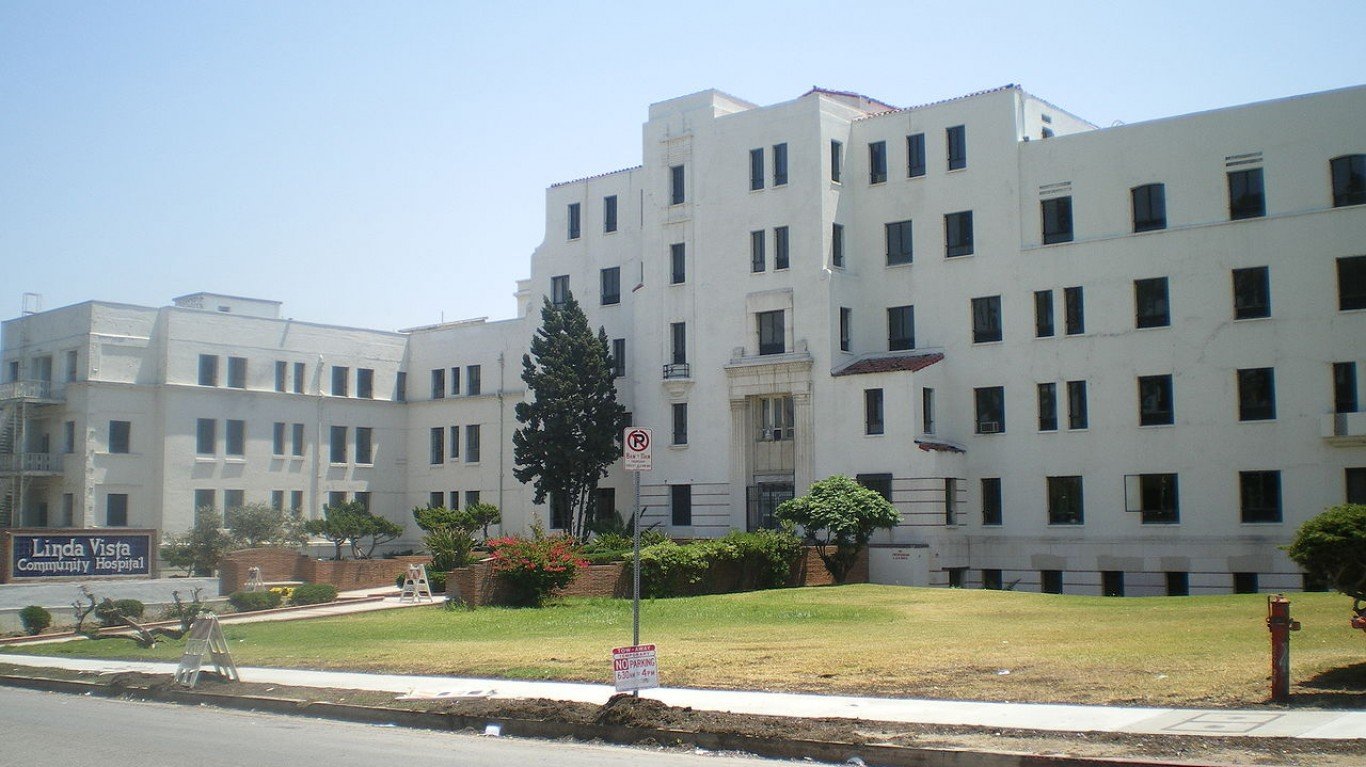
9. Louisiana
> Cancer diagnoses in 2016 per 100K: 473.1 (37 more than U.S. avg. of 436)
> Total number of cancer diagnoses in 2016: 25,451
> Cancer deaths: 9,149 or 171.7 per 100K (10th highest)
> Female breast cancer incidence: 3,494 or 123.9 per 100K (20th lowest)
> Prostate cancer incidence: 3,526 or 132.2 per 100K (3rd highest)
> Lung cancer incidence: 3,492 or 63.8 per 100K (14th highest)
> Adult smoking rate: 22.8% (4th highest)
> Adult obesity rate: 35.3% (3rd highest)
> Residents without health insurance: 8.0% (25th highest)

8. Maine
> Cancer diagnoses in 2016 per 100K: 473.4 (37 more than U.S. avg. of 436)
> Total number of cancer diagnoses in 2016: 8,901
> Cancer deaths: 3,275 or 169.4 per 100K (12th highest)
> Female breast cancer incidence: 1,187 or 125.8 per 100K (22nd lowest)
> Prostate cancer incidence: 815 or 81.7 per 100K (4th lowest)
> Lung cancer incidence: 1,453 or 73.5 per 100K (5th highest)
> Adult smoking rate: 19.8% (14th highest)
> Adult obesity rate: 29.4% (25th lowest)
> Residents without health insurance: 8.0% (25th highest)
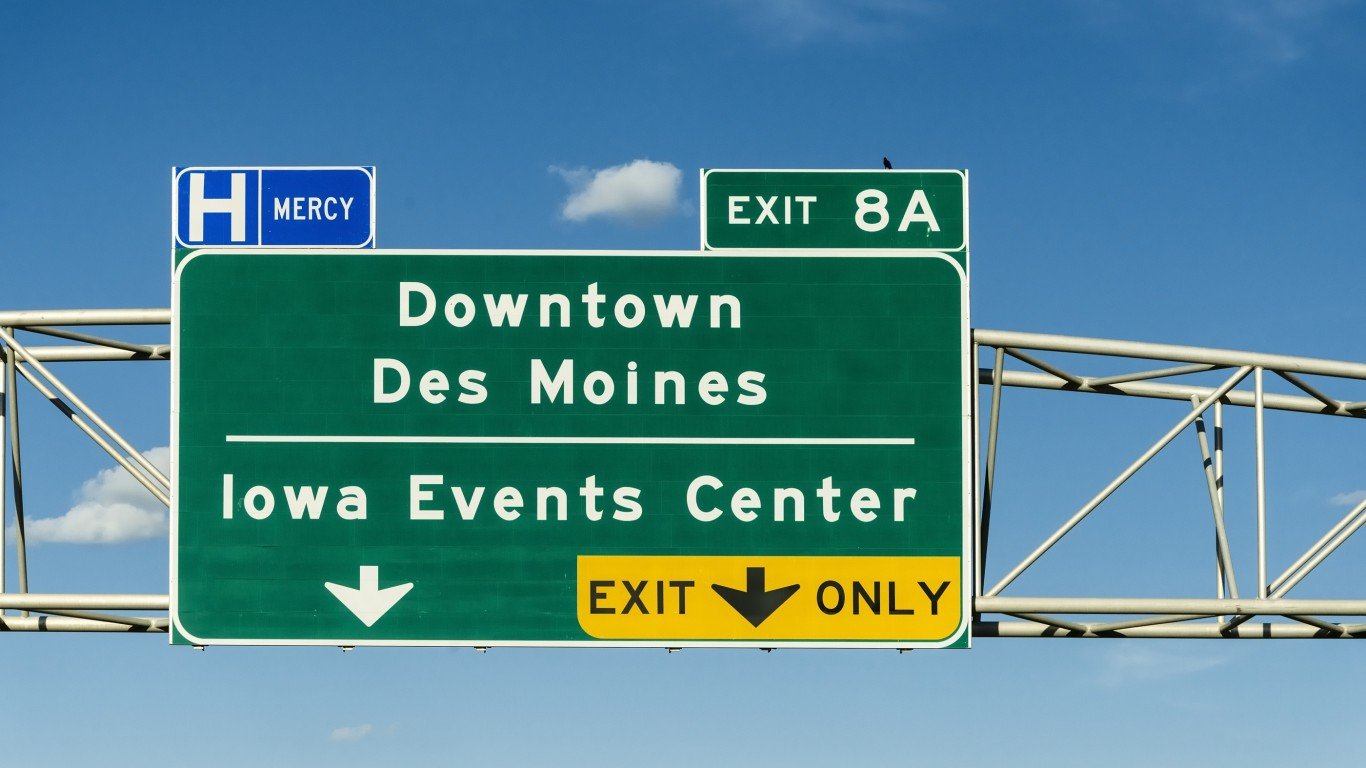
7. Iowa
> Cancer diagnoses in 2016 per 100K: 473.6 (38 more than U.S. avg. of 436)
> Total number of cancer diagnoses in 2016: 18,146
> Cancer deaths: 6,432 or 160.2 per 100K (22nd highest)
> Female breast cancer incidence: 2,496 or 129.4 per 100K (17th highest)
> Prostate cancer incidence: 2,059 or 105.7 per 100K (24th highest)
> Lung cancer incidence: 2,341 or 58.6 per 100K (23rd highest)
> Adult smoking rate: 16.7% (22nd lowest)
> Adult obesity rate: 32.2% (12th highest)
> Residents without health insurance: 4.7% (6th lowest)
[in-text-ad-2]
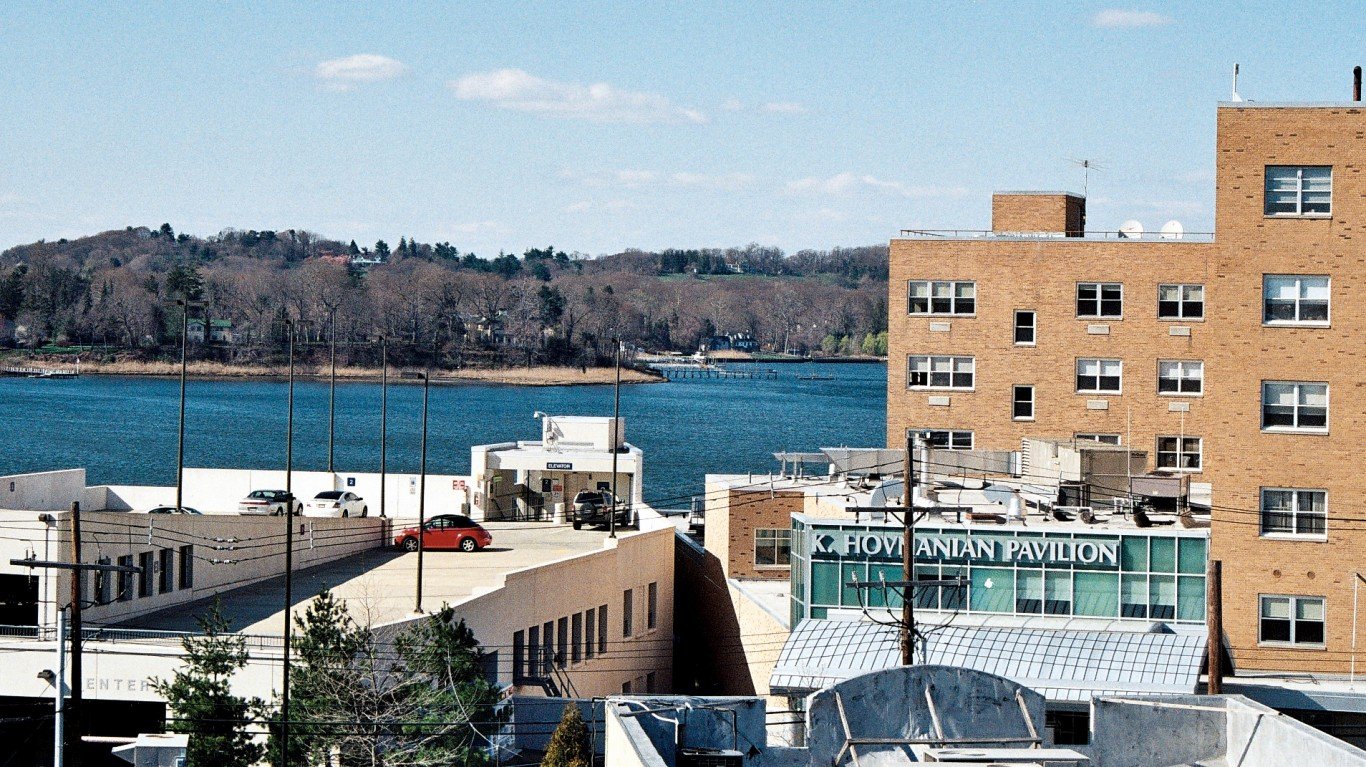
6. New Jersey
> Cancer diagnoses in 2016 per 100K: 474.8 (39 more than U.S. avg. of 436)
> Total number of cancer diagnoses in 2016: 51,521
> Cancer deaths: 16,377 or 148.5 per 100K (13th lowest)
> Female breast cancer incidence: 7,634 or 133.3 per 100K (7th highest)
> Prostate cancer incidence: 7,143 or 135.8 per 100K (the highest)
> Lung cancer incidence: 5,880 or 53.6 per 100K (16th lowest)
> Adult smoking rate: 14.0% (8th lowest)
> Adult obesity rate: 26.2% (11th lowest)
> Residents without health insurance: 7.4% (23rd lowest)

5. New York
> Cancer diagnoses in 2016 per 100K: 474.8 (39 more than U.S. avg. of 436)
> Total number of cancer diagnoses in 2016: 113,026
> Cancer deaths: 35,363 or 145.3 per 100K (10th lowest)
> Female breast cancer incidence: 16,057 or 129.1 per 100K (18th highest)
> Prostate cancer incidence: 14,174 or 123.2 per 100K (6th highest)
> Lung cancer incidence: 13,871 or 56.9 per 100K (24th lowest)
> Adult smoking rate: 14.2% (9th lowest)
> Adult obesity rate: 25.7% (9th lowest)
> Residents without health insurance: 5.4% (9th lowest)
[in-text-ad]

4. New Hampshire
> Cancer diagnoses in 2016 per 100K: 480.9 (45 more than U.S. avg. of 436)
> Total number of cancer diagnoses in 2016: 8,442
> Cancer deaths: 2,875 or 163.9 per 100K (17th highest)
> Female breast cancer incidence: 1,304 or 145.6 per 100K (the highest)
> Prostate cancer incidence: 984 or 106.1 per 100K (22nd highest)
> Lung cancer incidence: 1,134 or 62.4 per 100K (17th highest)
> Adult smoking rate: 18.0% (20th highest)
> Adult obesity rate: 28.0% (18th lowest)
> Residents without health insurance: 5.7% (14th lowest)

3. Pennsylvania
> Cancer diagnoses in 2016 per 100K: 482.5 (47 more than U.S. avg. of 436)
> Total number of cancer diagnoses in 2016: 80,089
> Cancer deaths: 28,492 or 164.3 per 100K (16th highest)
> Female breast cancer incidence: 11,287 or 132.8 per 100K (11th highest)
> Prostate cancer incidence: 8,853 or 106.6 per 100K (21st highest)
> Lung cancer incidence: 10,941 or 62.9 per 100K (16th highest)
> Adult smoking rate: 18.0% (21st highest)
> Adult obesity rate: 29.9% (25th highest)
> Residents without health insurance: 5.5% (11th lowest)

2. Delaware
> Cancer diagnoses in 2016 per 100K: 487.2 (51 more than U.S. avg. of 436)
> Total number of cancer diagnoses in 2016: 6,001
> Cancer deaths: 2,124 or 170.9 per 100K (11th highest)
> Female breast cancer incidence: 841 or 133.3 per 100K (7th highest)
> Prostate cancer incidence: 753 or 120.8 per 100K (9th highest)
> Lung cancer incidence: 862 or 67.1 per 100K (10th highest)
> Adult smoking rate: 17.7% (24th highest)
> Adult obesity rate: 30.6% (20th highest)
> Residents without health insurance: 5.7% (14th lowest)
[in-text-ad-2]

1. Kentucky
> Cancer diagnoses in 2016 per 100K: 509.7 (74 more than U.S. avg. of 436)
> Total number of cancer diagnoses in 2016: 27,137
> Cancer deaths: 10,363 or 194.2 per 100K (the highest)
> Female breast cancer incidence: 3,482 or 126.1 per 100K (24th lowest)
> Prostate cancer incidence: 2,722 or 101.4 per 100K (22nd lowest)
> Lung cancer incidence: 4,761 or 86.8 per 100K (the highest)
> Adult smoking rate: 24.5% (2nd highest)
> Adult obesity rate: 34.2% (6th highest)
> Residents without health insurance: 5.6% (12th lowest)
Nationwide in 2016, the latest year for which data is available, 436 new cancer cases were diagnosed for every 100,000 people. In the U.S., approximately 40 out of 100 men and 38 out of 100 women will develop some form of cancer during their lifetime – these are the most common types of cancer in men and women.
Breast cancer is by far the most commonly diagnosed form of cancer when adjusted to the population of every state in all but six states. In those six states, prostate cancer is the most common. However, breast and prostate cancers are not the deadliest. Lung cancer has the highest mortality rate of all cancers in every state.
The likelihood of being diagnosed with cancer depends on a range of factors that contribute to large variations in cancer incidence between states. Smoking and obesity can significantly increase the risk of a variety of cancers. For example, lung cancer is most closely related to smoking rates. Breast cancer, by contrast, is more associated with obesity than with smoking.
There is some evidence that patients’ survival time is partially linked to insurance status. Regardless of cancer type, privately insured individuals tend to be diagnosed earlier and live longer than cancer patients who are uninsured or covered by Medicaid, according to two studies published in the journal Cancer. People with health insurance are more likely to get screened because they don’t have to pay prohibitively high out-of-pocket prices for tests, and the earlier the disease is caught, the better the chances of survival.
Methodology
To identify the incidence of cancer in every state, 24/7 Tempo reviewed the age-adjusted cancer incidence rate in every state using data compiled by the Centers for Disease Control and Prevention. The rate represents the number of new cancer diagnoses per 100,000 people during 2016, the latest year for which data is available, in all 50 states.
The data is from the report, “United States Cancer Statistics: 2000-2016 Incidence and Mortality Web-based Report,” produced by the U.S. Department of Health and Human Services, Centers for Disease Control and Prevention and the National Cancer Institute, published in June 2019. The percentage of adults who currently smoke in each state as well as the adult obesity rate in every state were obtained from the 2019 County Health Rankings & Roadmaps program, produced by the Robert Wood Johnson Foundation and the University of Wisconsin Population Health Institute. The percentage of residents in every state without health insurance came from the Census Bureau’s American Community Survey 2018 1-Year Estimates.
Essential Tips for Investing: Sponsored
A financial advisor can help you understand the advantages and disadvantages of investment properties. Finding a qualified financial advisor doesn’t have to be hard. SmartAsset’s free tool matches you with up to three financial advisors who serve your area, and you can interview your advisor matches at no cost to decide which one is right for you. If you’re ready to find an advisor who can help you achieve your financial goals, get started now.
Investing in real estate can diversify your portfolio. But expanding your horizons may add additional costs. If you’re an investor looking to minimize expenses, consider checking out online brokerages. They often offer low investment fees, helping you maximize your profit.
Thank you for reading! Have some feedback for us?
Contact the 24/7 Wall St. editorial team.
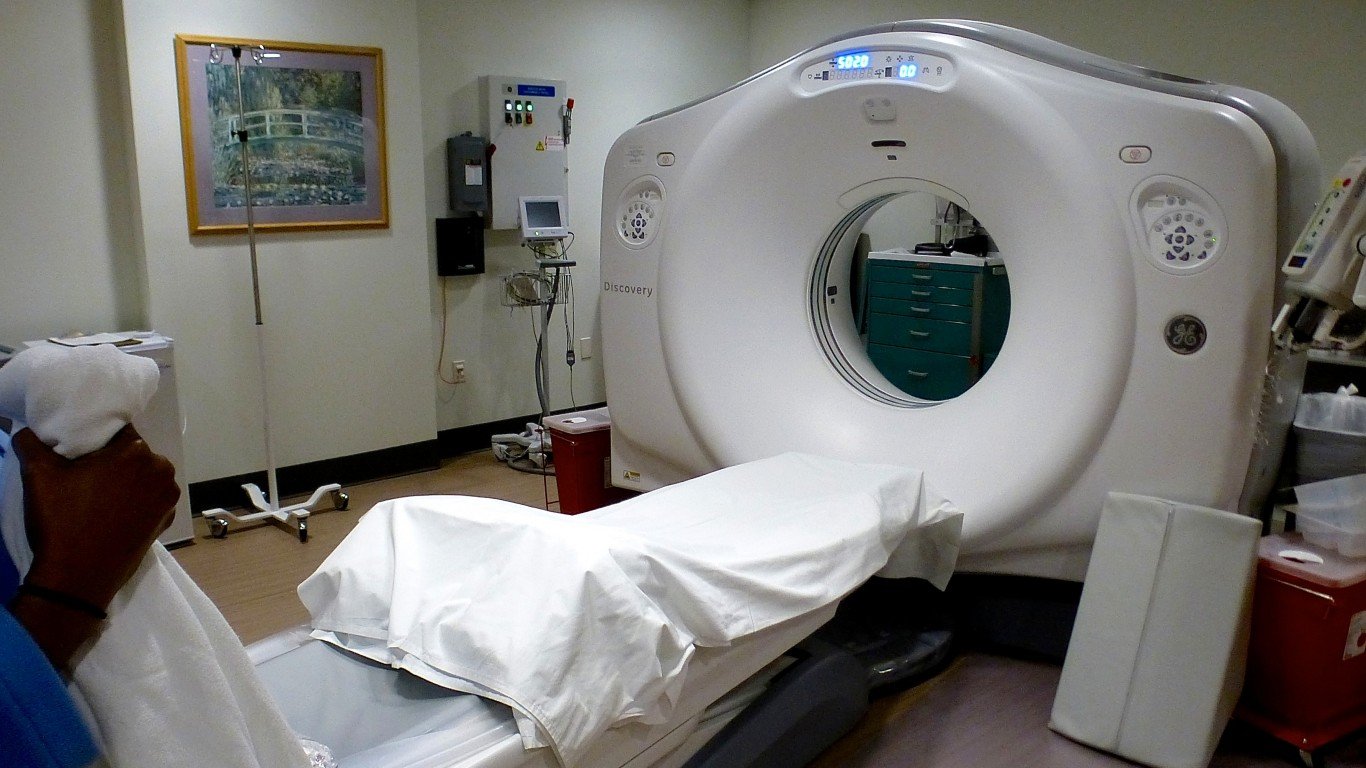
 24/7 Wall St.
24/7 Wall St.
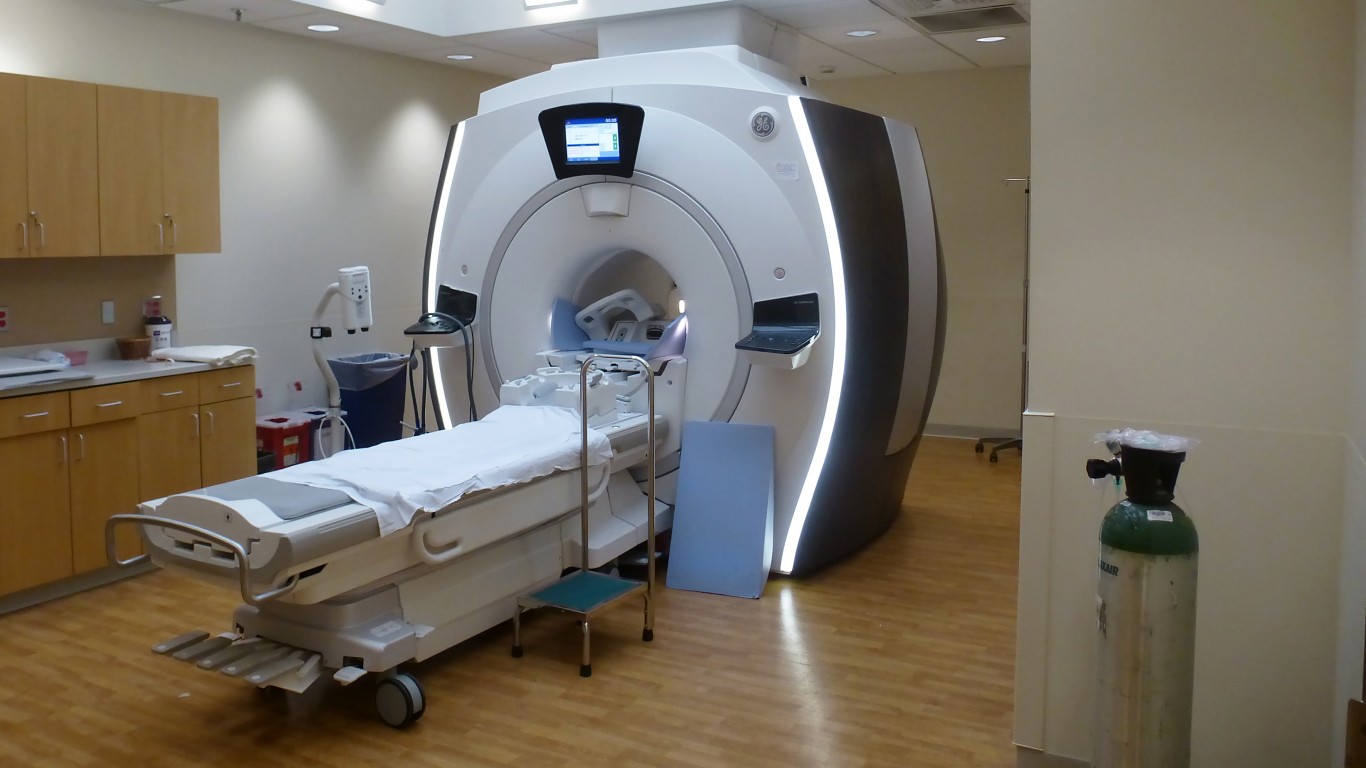
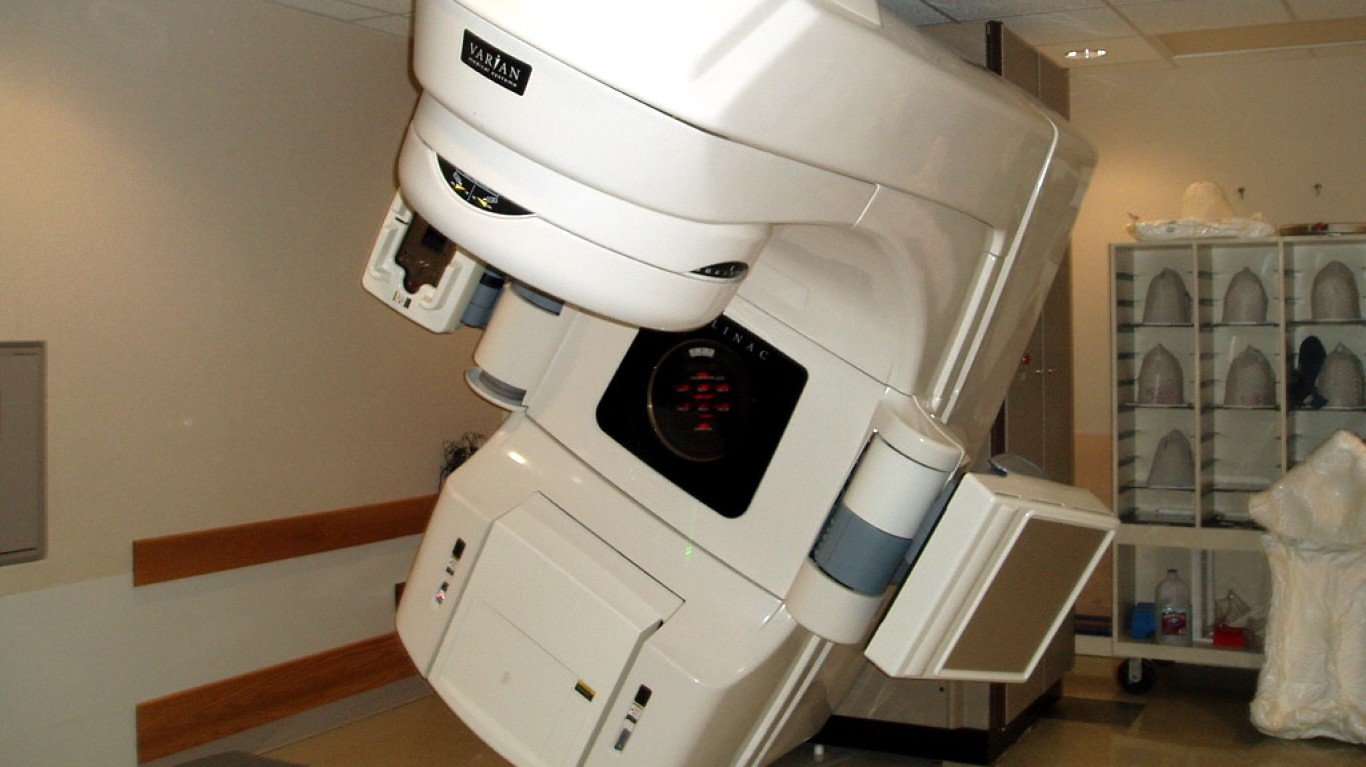
 24/7 Wall St.
24/7 Wall St.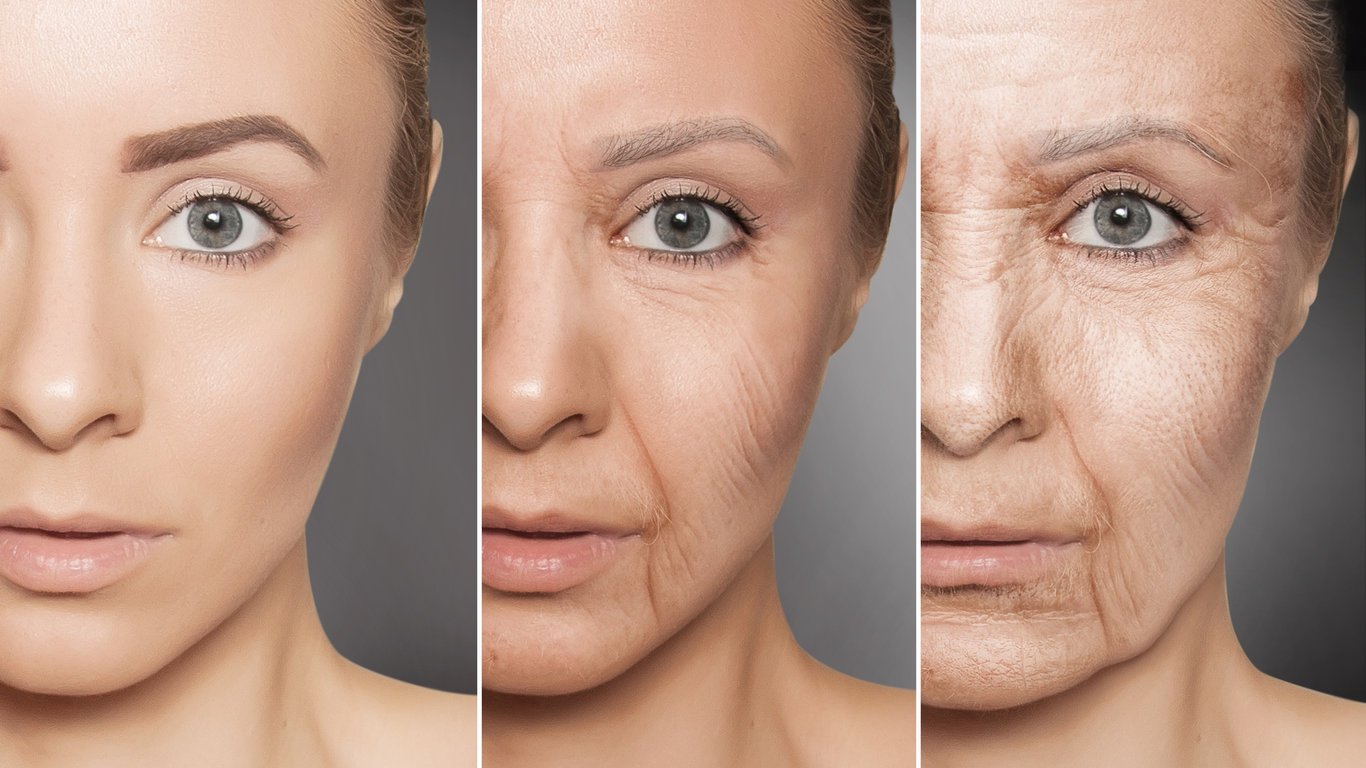 24/7 Wall St.
24/7 Wall St.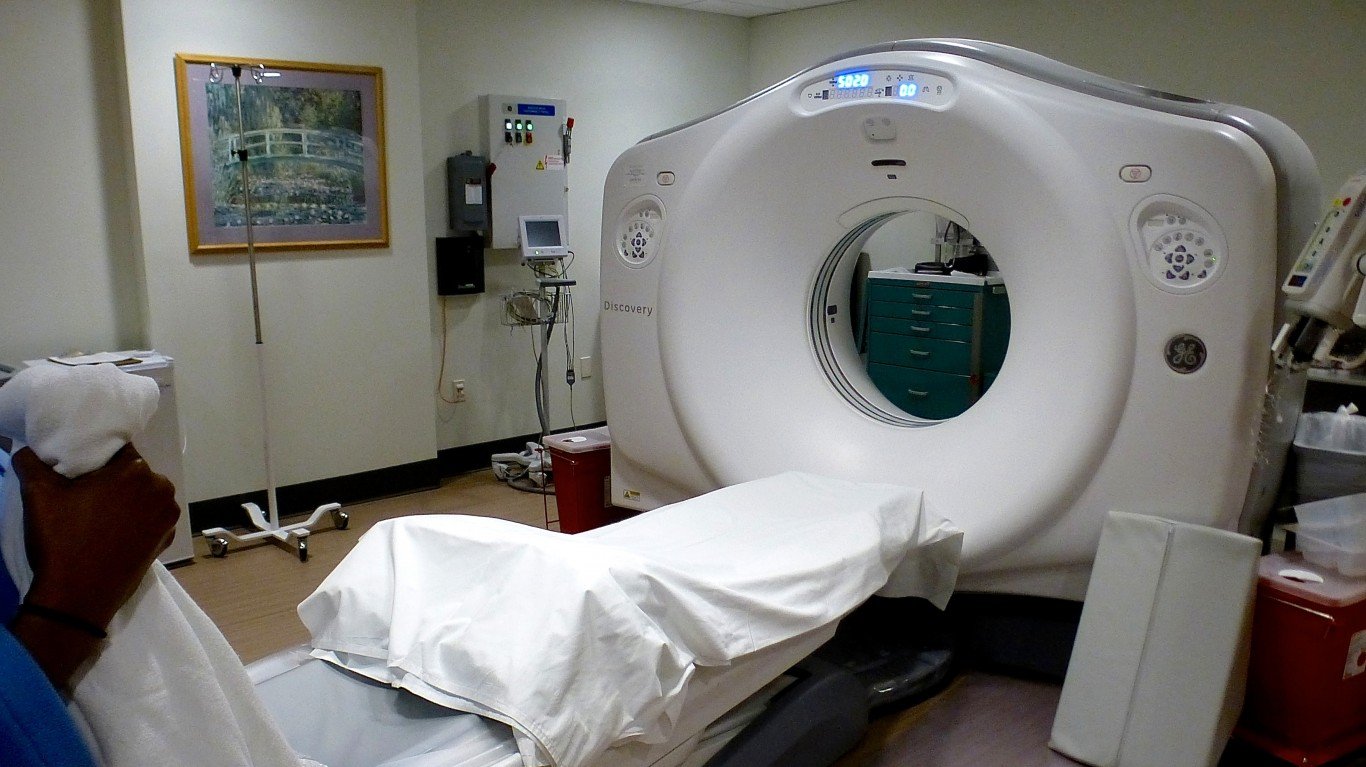
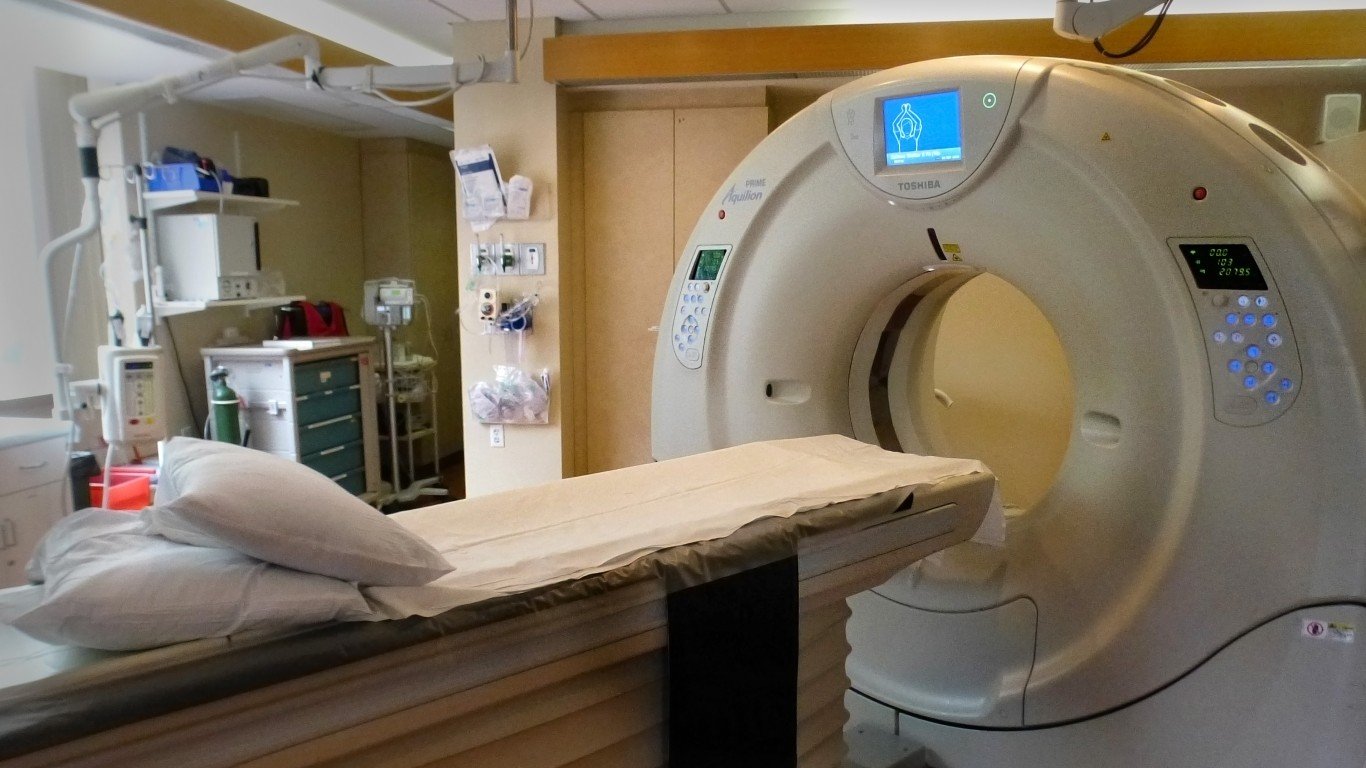
 24/7 Wall St.
24/7 Wall St. 24/7 Wall St.
24/7 Wall St. 24/7 Wall St.
24/7 Wall St.


